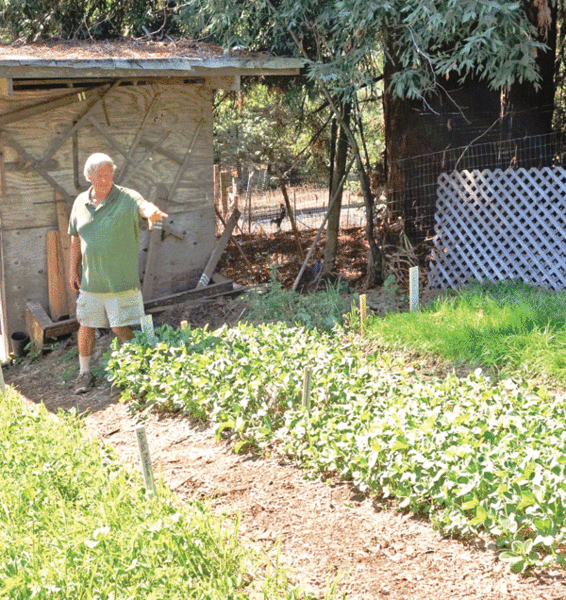Every drop of rain that hits bare soil is destructive. More than 3,000 years ago the Chinese knew how to protect their soil from erosion and increase fertility by planting cover crops. Early Nile Valley inhabitants 3,500 years ago also practiced this method of agriculture as did first century Romans. Lupines were planted in poor soil when no animal manure was to be had. I learned this and also how to protect and improve my soil from Orin Martin, manager of the Alan Chadwick Garden at a cover crop workshop recently on the University of California, Santa Cruz campus.
“It’s all about the biology of the soil,” Martin said. “You grow the soil that helps you grow the plants”.
A cover crop is really anything that covers the soil and protects it from rain, trapping nutrients and preventing them from leaching downward, he explained. Cover crops can increase the tilth of the soil. Quick germinating grasses easily loosen the top foot of soil with their root mass. Legumes have a tap root — a bio drill — that penetrates 30 inches downward, while alfalfa roots can grow even deeper.
Cover crops like bell beans, vetch and fava beans are especially valuable as they increase nitrogen levels in the soil in two ways. Atmospheric nitrogen can be “fixed” and left in the soil to fertilize subsequent crops. This is in addition to the nitrogen left from the foliage of the legume.
Cover crops are also called green manure when they are chopped up and turned into the soil in spring before going to seed. The planting of legumes like peas and beans can actually increase nutrients in your soil giving you a net gain which is needed to offset what you take out of the soil when you harvest fruits, vegetables and flowers.
From late September to the end of November is the best time to sow cover crops. You will need to irrigate lightly a couple times per week if it doesn’t rain. You can also wait to sow just before the rains start. Be careful about working overly wet soil, however, as you can ruin the structure of your soil.
The Chadwick Garden, Martin explained, originally was heavy red clay. Thirty five years of soil building with bell beans and vetch cover crops and compost have established a level of fertility that now supports several acres of vegetables, fruit trees, berries and beneficial flowering plants. Fall-sown, spring ploughed-down cover crops are the sole fertilizer used for the better part of the last decade.
Martin explained that recent research now recommends planting a tandem of grasses and legumes. Annual cereal grasses such as oats, rye and barley germinate quickly to hold and shield the soil until the legumes take hold. Bell beans, fava beans and vetch which are the best legumes for our area grow slowly the first three months then take off growing 70 to 80 percent in the last three months. The ratio of grass seed to legumes can vary from 10 percent to 30 percent.
There are other legumes that fix nitrogen, just not as efficiently as bell beans. Crimson clover seed is also more expensive, needs lots of water to sprout and competes poorly with weeds. Mustard causes competition with the fruit trees, as bees will concentrate on the mustard flowers instead of the fruit tree flowers.
A question came up about using inoculants on legume seed. Martin explained that our soils have a native resident population of good bacteria that will break down the seed coat and encourage the plant roots to fix more nitrogen especially after cover cropping for a few years.
We all followed Martin out to the cover crop trial plots to see how the different types were growing. Bark chips will soon be applied to the paths. All of the gardens are mulched several times per year with wood chips. A 10-year study, Martin explained, demonstrated the amazing benefits of ramial chipped wood — the type the tree service companies provide for free.
We watched him work the soil lightly with a metal bow rake then broadcast 8 to 10 seeds per square-foot. Weeds were already cleared, but Martin said this step doesn’t have to be perfect. Afterward the area was raked again lightly 1 to 2 inches down and covered with 3 to 4 inches of straw. Wood chips would be fine, too. Mulch heavier if you have bird competition. Cover crops are vigorous and will come up through just about anything, he said. Water in lightly.
There are three ways to fertilize, Martin said. You can buy chemical fertilizer, which is expensive and doesn’t do much for the soil. You can apply compost which, being carbon based, ramps up beneficial fungal organisms in the soil. Or you can cover crop or grow green manure to increase beneficial soil bacteria. Martin has proof of the benefits of the latter two methods.











